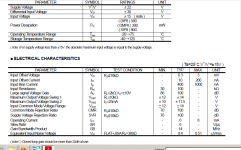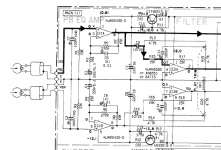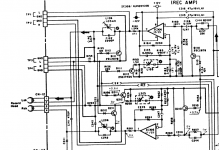Its a confusing datasheet. I think they are saying the 20kHz bandwidth input-refered noise is 0.9µV with a source impedance of 3k3, probably using an RIAA network. About 75 SNR for a 5mV signal.
Wish they would just give voltage noise and current noise graphs against frequency for the bare amp.
Wish they would just give voltage noise and current noise graphs against frequency for the bare amp.
HA1457 was specifically a high-end phono preamp. Note the high +/-25V rail ratings, reflecting the trend for Japanese gear to give enormous phono overload level.
The power voltages in post #1 are in excess of even the best-spec '5534/'5532; post #35 a hair high. So this becomes a re-think.
The power voltages in post #1 are in excess of even the best-spec '5534/'5532; post #35 a hair high. So this becomes a re-think.
Yeah, the supply voltages of +/- 22 volts do present a problem. The old high voltage version of the LM4562 (LM49860?) would take those voltages, but is currently unobtanium. If the voltages could be lowered to +/- 18v, the OPA2228 is about the quietest MM opamp available.
Yeah, the supply voltages of +/- 22 volts do present a problem. The old high voltage version of the LM4562 (LM49860?) would take those voltages, but is currently unobtanium. If the voltages could be lowered to +/- 18v, the OPA2228 is about the quietest MM opamp available.
Nope, that's not true as it has a bias current cancellation scheme which means the current noise in an unbalanced configuration like an RIAA amp will be far higher than the datasheet value.
NE5534A is the bipolar opamp to go to for MM, otherwise choose a low voltage noise JFET device.
Please explain "bias cancellation scheme". I do note that the NE5534 will take up to +/-22 volt rails.Nope, that's not true as it has a bias current cancellation scheme which means the current noise in an unbalanced configuration like an RIAA amp will be far higher than the datasheet value.
NE5534A is the bipolar opamp to go to for MM, otherwise choose a low voltage noise JFET device.
M5220 was the better op-amp to replace HA1457.It was often found in good quality cassette decks. NJM2043 can do it too, being more powerful than ne5532, but with a high risk as it's supplied at the limit.
Anyway, reworked the regulator to supply +/- 16V, and built my own adapter since I couldn't get ahold of the guy who apparently has some premade ones.
Heey Echo......
Just for the future... If you ever need any (and sorry for being late with this info) 🙂
DIP-8 to TO-99-8 Adapter - BrownDog Adapters - 020601A
Through-Hole Adapters - Cimarron Technology
Surface Mount Adapters - Cimarron Technology
Last edited:
Yes, I believe you are correct! The M5220 has better specs, and will take up to +/- 25 v rails. Available here:M5220 was the better op-amp to replace HA1457.It was often found in good quality cassette decks.
M5220L Mitsubishi datasheet | Octopart
The Armstrong 700 Series - page 5Yes, I believe you are correct! The M5220 has better specs, and will take up to +/- 25 v rails. Available here:
M5220L Mitsubishi datasheet | Octopart
http://www.audiomisc.co.uk/Armstrong/700/730circuit.gif
HA12017 Datasheet PDF - Datasheet4U.com
Last edited:
@Boydk -- for the the HA1457 replacement, they have a specific board adapter
HA1457 Upgrade Adapter – BrownDog 140901
HA1457 Upgrade Adapter - BrownDog Adapters - 140901
HA1457 Upgrade Adapter – BrownDog 140901
HA1457 Upgrade Adapter - BrownDog Adapters - 140901
Nope, that's not true as it has a bias current cancellation scheme which means the current noise in an unbalanced configuration like an RIAA amp will be far higher than the datasheet value.
NE5534A is the bipolar opamp to go to for MM, otherwise choose a low voltage noise JFET device.
I like the LT1115, but maybe I'm biased since I worked at LTC for almost 30 years....
tommost
unfortunately he also needs an op-amp to take +-23.7v rail supply on board too...@Boydk -- for the the HA1457 replacement, they have a specific board adapter
HA1457 Upgrade Adapter – BrownDog 140901
HA1457 Upgrade Adapter - BrownDog Adapters - 140901
Interesting---this preamp uses the exact same IC (HA12017) that is employed as a magnetic tape reproduce head amplifier in my Otari MX5050 tape machine; they also conclude, as I have, that this IC is too noisy to use alone to amplify a very low-level signal (~2 mV at maybe 2KΩ source impedance)); They utilized a transistor-based gain circuit to amplify the signal to the point where the HA12017's noise is not a factor. I am trying to select a modern IC that will replace the 12017; so far it appears that the old NE5534A may be the best. I am trying to interpret the noise figures quoted on the HA12017 datasheet (HA12017 Datasheet PDF - Datasheet4U.com). It's confusing, as they quote two figures---one with an RIAA equalization, and one with a 40 db amplifier. Anyone able to decode these datasheet figures into voltage and current noise density?
Last edited:
As the pin sequence usually is identical for TO-99 and DIP-8 versions of the same IC, a DIP to TO adaptor isn't needed in this case.Heey Echo......
Just for the future... If you ever need any (and sorry for being late with this info) 🙂
DIP-8 to TO-99-8 Adapter - BrownDog Adapters - 020601A
Through-Hole Adapters - Cimarron Technology
Surface Mount Adapters - Cimarron Technology
Best regards!
in the mx5050 i see NJM2043 as the input op-amp for the repro head...that's one of the best op-amps ever made. njm2043 , m5219, m5220 are very good for that spot as you have +-18v supply.Interesting---this preamp uses the exact same IC (HA12017) that is employed as a magnetic tape reproduce head amplifier in my Otari MX5050 tape machine; they also conclude, as I have, that this IC is too noisy to use alone to amplify a very low-level signal (~2 mV at maybe 2KΩ source impedance)); They utilized a transistor-based gain circuit to amplify the signal to the point where the HA12017's noise is not a factor. I am trying to select a modern IC that will replace the 12017; so far it appears that the old NE5534A may be the best. I am trying to interpret the noise figures quoted on the HA12017 datasheet (HA12017 Datasheet PDF - Datasheet4U.com). It's confusing, as they quote two figures---one with an RIAA equalization, and one with a 40 db amplifier. Anyone able to decode these datasheet figures into voltage and current noise density?
Last edited:
I believe there are several versions of the Otari MX5050---mine is an MX 5050III-8 that has the Hitatchi HA12017. Surely the NJM2043, with its 6v/µSec slew rate, 2µV EIN, and (as all NJM products) unspecified THD, cannot be compared to the likes of an NE5534, LM4562, or OPA1656.in the mx5050 i see NJM2043 as the input op-amp for the repro head...that's one of the best op-amps ever made. njm2043 , m5219, m5220 are very good for that spot as you have +-18v supply.
🙂))))))Surely the NJM2043, with its 6v/µSec slew rate, 2µV EIN, and (as all NJM products) unspecified THD, cannot be compared to the likes of an NE5534, LM4562, or OPA1656.
njm2043 can do something that none of those op-amps can: it will work with VCE-0.25 v output offset ! Its slew rate is good enough, its combined noise is actually lower than NE5532, its 400ohms drive...
Below you have Yamaha KX-930 tape play head preamp , and Nakamichi CR-4(all Nakamichi dragon, zxl-1000 have the same schematic on that side) rec head amp...you might argue that the tape noise is masking njm2043 noise, but you need to build something based on bjm2043 to really understand what it is.
Attachments
Last edited:
How do you figure that? NJM's noise specs are quite an enigma.Its [njm2043] slew rate is good enough, its combined noise is actually lower than NE5532, its 400ohms drive...
I like the LT1115, but maybe I'm biased since I worked at LTC for almost 30 years....
tommost
Which has 3 times the current noise of the NE5534A. Current noise can dominate for MM at higher frequencies due to the massive inductive impedance of a cartridge (~0.5 henries is common, ie ~15k impedance at 5kHz and rising).
The LT1115 will suit a MC cartridge much better as current noise is of no concern at a few dozen ohms, whereas voltage noise is everything.
- Home
- Source & Line
- Analogue Source
- Replacing Dead Phono Opamp...What to Use??


